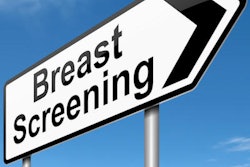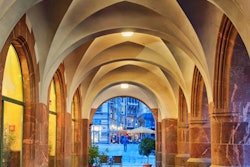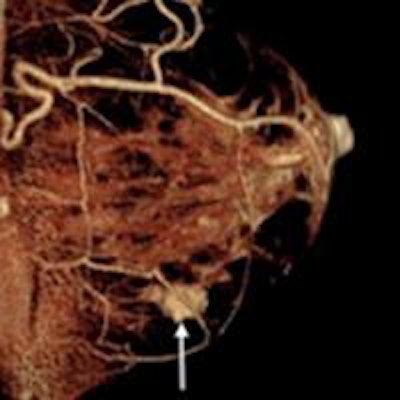
The German screening program for breast cancer relies entirely on mammography, but this method has its limitations, not least in women with dense glandular breast tissue; the denser the breast, the more difficult it is to detect malignant tumors. MRI, ultrasound, and tomosynthesis examinations as well as new techniques such as 3D cone-beam breast CT can help to create a more targeted approach toward breast cancer screening and diagnostic tests, and improve the ability to adjust them to individual needs.
New research on this topic is being presented at this week's national German radiology congress (Deutscher Röntgenkongress, DRK 2016), which takes place in Leipzig from 4 to 7 May.
In the German breast screening program, mammography is always used to detect suspicious structures in the breast. If necessary, findings are then examined in more detail in a second step by means of additional imaging methods and needle biopsies. The standardized approach has many advantages, but does not meet the needs of every woman.
 The cone-beam breast CT device from Koning. A: Examination table with integrated horizontally arranged gantry. B: View of the breast unit positioned under the table. C: Dedicated intervention unit for interventional procedures (biopsy, localization). All images courtesy of Diagnostic Breast Center Göttingen.
The cone-beam breast CT device from Koning. A: Examination table with integrated horizontally arranged gantry. B: View of the breast unit positioned under the table. C: Dedicated intervention unit for interventional procedures (biopsy, localization). All images courtesy of Diagnostic Breast Center Göttingen."The method has its limitations in women with dense breast tissue. Studies in this area show that when mammography is performed on 100 malignant tumors, about 40 are missed," said Dr. Susanne Wienbeck, a radiologist at the Institute for Diagnostic and Interventional Radiology and Breast Center of the University Medical Center Göttingen.
Wienbeck and other radiologists who explore breast cancer diagnostics therefore advocate a more individualized screening approach to increase the odds of detection, thereby improving the overall success rates of screening.
Cone beam CT: Modern screening methods in the wings?
This also entails the assessment of other methods of screening or diagnostic evaluations. MRI and ultrasound in combination with mammography can markedly improve the breast cancer detection rate in dense breast tissue, but they also have disadvantages: MRI is comparatively expensive and far from universally available, and ultrasound is labor-intensive and highly dependent on the experience of the examiner. Another interesting method that uses x-rays is tomosynthesis.
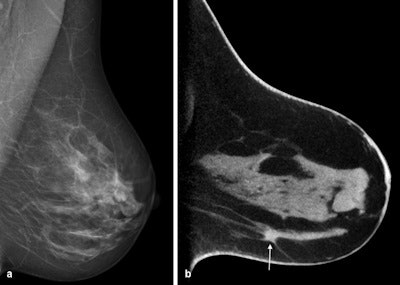 Cone-beam breast CT, noncontrast-enhanced examination. Invasive ductal breast carcinoma is shown on the left. A: Digital mammography on the left in mediolateral oblique (MLO) projection. B: Breast CT, sagittal single slice with depiction of breast carcinoma (arrow) in the caudal breast sections.
Cone-beam breast CT, noncontrast-enhanced examination. Invasive ductal breast carcinoma is shown on the left. A: Digital mammography on the left in mediolateral oblique (MLO) projection. B: Breast CT, sagittal single slice with depiction of breast carcinoma (arrow) in the caudal breast sections."The Norwegian screening program already showed that when this method is used in combination with mammography, the tumor detection rate can be increased," Wienbeck noted.
At DRK 2016, she is reporting on a further development in tomosynthesis: cone-beam breast CT. Unlike tomosynthesis, this method actually allows for a 3D dataset to be acquired.
Cone-beam breast CT has some advantages that may render the method an interesting option for breast cancer screening in the future. On the one hand, thanks to 3D image acquisition, the location of suspicious structures can be determined precisely in all spatial directions. On the other hand, findings can be evaluated immediately by taking a tissue sample, thus sparing the affected women days of uncertainty. Compared with mammography, the method is also more comfortable for the women because the breast does not need to be compressed during the examination.
High detection rates in pilot study
From the standpoint of technology, the researchers in Göttingen are way ahead of other colleagues.
"There are only seven such devices in the world, and we are the only ones in Europe who use this technology in breast cancer diagnostics," said Wienbeck, who is working with Dr. Uwe Fischer, a professor of radiology, in whose medical office the new device is located.
 Top: Cone-beam breast CT, noncontrast-enhanced examination. Invasive ductal breast carcinoma is visible on the left. A: Digital mammography on the left in MLO projection. B: Breast CT, sagittal single layer with breast carcinoma (arrow) in the caudal breast sections. C: Coronal single slice with depiction of the tumor within the dense glandular breast tissue. Bottom: Cone-beam breast CT, noncontrast-enhanced examination. Mucinous breast carcinoma on the left. A: Sagittal single slice. B: Maximum intensity projection (MIP) of the dataset with breast carcinoma in the caudal breast sections. C: Reconstructed image with depiction of the surfaces of the intramammary structures and the tumor (arrow).
Top: Cone-beam breast CT, noncontrast-enhanced examination. Invasive ductal breast carcinoma is visible on the left. A: Digital mammography on the left in MLO projection. B: Breast CT, sagittal single layer with breast carcinoma (arrow) in the caudal breast sections. C: Coronal single slice with depiction of the tumor within the dense glandular breast tissue. Bottom: Cone-beam breast CT, noncontrast-enhanced examination. Mucinous breast carcinoma on the left. A: Sagittal single slice. B: Maximum intensity projection (MIP) of the dataset with breast carcinoma in the caudal breast sections. C: Reconstructed image with depiction of the surfaces of the intramammary structures and the tumor (arrow).For her pilot study, Wienbeck examined more than 100 female patients by means of cone-beam breast CT, including both women with malignant cancer as well as those with benign findings.
"The most important outcome is that this new method allows us to detect a very high percentage of malignant tumors," she stated.
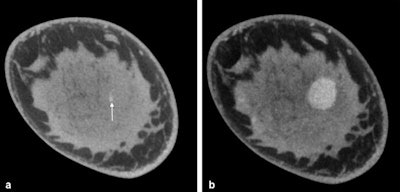 Cone-beam breast CT, contrast-enhanced examination. Each image shows the coronal single slice with invasive ductal breast carcinoma on the right. A: Prior to administering the contrast agent, only dense glandular tissue (ACR IV) and a calcified particle (arrow) in the tumor area. B: After administering the contrast agent, depiction of carcinoma portions with intense contrast agent uptake.
Cone-beam breast CT, contrast-enhanced examination. Each image shows the coronal single slice with invasive ductal breast carcinoma on the right. A: Prior to administering the contrast agent, only dense glandular tissue (ACR IV) and a calcified particle (arrow) in the tumor area. B: After administering the contrast agent, depiction of carcinoma portions with intense contrast agent uptake.However, even this method is somewhat dependent on the density of the breast: The detection rates are lower with dense breast tissue. In this case, the detection rate can be improved by administering a contrast agent. To evaluate how cone-beam CT fares against mammography, the researchers are now embarking on a larger clinical study, during which the team from Göttingen will collaborate with their peers in Norway and Berlin.
 Dr. Susanne Wienbeck, a radiologist at the Diagnostic Breast Center Göttingen.
Dr. Susanne Wienbeck, a radiologist at the Diagnostic Breast Center Göttingen.Overall, Wienbeck now sees breast cancer diagnostics on a path that imaging techniques for other organs have already followed.
"We replaced conventional film-screen mammography with digital mammography and, with the use of CT technology, we are now moving to the third dimension. For breast cancer, this is still a new field. But we know from other areas, such as lung cancer diagnostics, that it will make us so much better."
This is a good example of how cutting-edge research can take place in close collaboration between universities and peers in private practice, according to Dr. Joachim Lotz, head and professor of radiology at the University Medical Center Göttingen.
Editor's note: This article is an edited version of a translation of an article published in German online by the German Radiological Society (DRG, Deutsche Röntgengesellschaft). Translation by Syntacta Translation & Interpreting. To read the original article, visit the DRG website.




